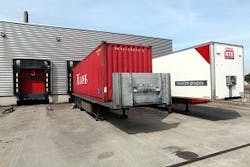When it comes to loading and unloading goods and equipment, safety ensures integrity of loads and good health of employees. To set up your loading dock for success, consider the following safety suggestions.
1. Don’t skimp on safety regarding oily and wet floor surfaces. Surfaces get slick quickly when it’s raining and snowing. Furthermore, foods, oils, and debris leak from boxes and trucks, creating a slippery surface for unsuspecting workers.
Solutions, including sawdust on floor surfaces for added traction, help managers to keep workers safe. Furthermore, alert personnel of surfaces prone to slickness and make slip-resistant boots a part of the required uniform.
Use scaffolds to created added space for shipping and receiving. Heavy or awkward-shaped boxes and materials make workers lose balance and fall off small loading dock ramps, but scaffolds allow workers to add or subtract scaffold components as needed.
3. Workers use dollies and machinery to transport goods. It’s common for busy workers to forget simple things, such as locking a wheel in place. Regardless of known protocol, some equipment poses more added risks than others.
Wheeling materials or using pulls that operate on wheels is convenient, but consider the risk posed to workers. Reconsider the number of workers assigned to shipments; having more workers increases costs but decreases risk of injuries.
4. It’s common for loading dock workers to hurt their lower backs. Workers are urged to lift at the knees, pressing materials upward with muscles of the legs rather than with the arms and lower back.
Provide lifting belts, ones especially made for warehouse technicians and those who do a lot of heavy lifting, for workers. The belts isolate the lower back, making workers lift at the knees and making it impossible to place the lower back in a vulnerable position.
5. Chemical spills place workers at immediate and time-sensitive risk, creating an immediate slick surface, but accidental inhalation or ingestion could be disastrous at best and deadly at worst.
Be sure workers are aware of expected materials in addition to adhering to protocol in the case of a spill, whether that means having masks handy or calling specialists who are trained to address chemical spills.
6. Consider an increase in security, inserting cameras around the perimeter of the loading dock and property of the business. Implementing more security could present an opportunity to save money on insurance costs. Moreover, increased security adds to the peace of mind of investors, clients, and partners.
Depending on time of shipments and shape of loading area, consider supplementing cameras with extra personnel or security guards and watchdogs. Thieves prey on vulnerable businesses, those without safety precautions in place. Have managers make note of possible holes in loading dock security.
7. In addition to security and added personnel, consider implementing accessories throughout the loading dock. Bumpers, reflective barricades, and neon vests help drivers to see corners, edges, and workers. In addition, schedule checks and have equipment replaced due to wear and time expiration.
8. Consider hiring an outside consultant to assess the efficiency and safety of machinery, workers, and locations. You may find age-old traditions are out-of-date compared to available technologies or arrangements of competitors.
9. Do not accept anything but the best when it comes to training new personnel. Learning how to do things right the first time is integral to efficient business operations competitive advantage. Invest in better training videos, equipment, and in-house and outside trainers.
10. Rather wait for employees to come to you, be proactive on social media platforms such as LinkedIn to find new employees and management potential. Be concerned with hiring the best people available for your positions. Excellence starts with higher expectations. Let interested parties know your company is interested in hiring the best talent. Committed employees help make loading areas efficient and safe.


